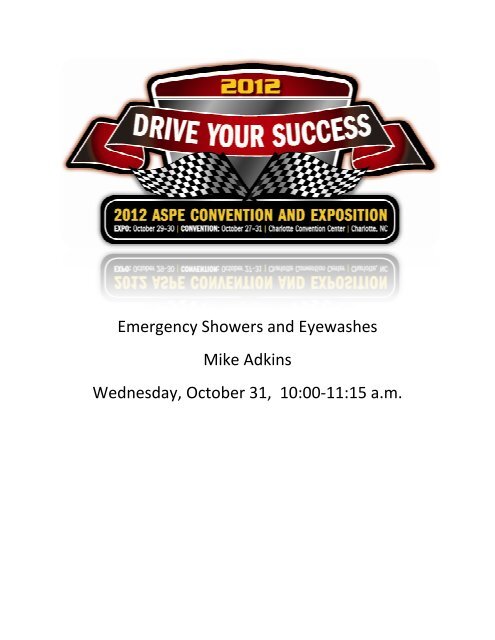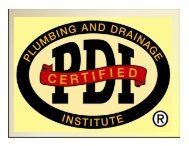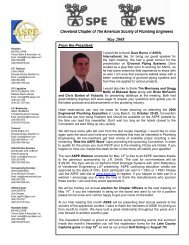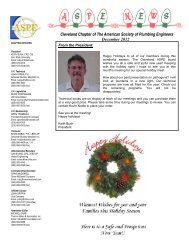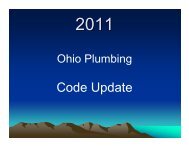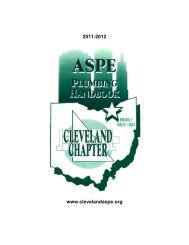Emergency Showers and Eyewashes - CLEVELAND AMERICAN ...
Emergency Showers and Eyewashes - CLEVELAND AMERICAN ...
Emergency Showers and Eyewashes - CLEVELAND AMERICAN ...
You also want an ePaper? Increase the reach of your titles
YUMPU automatically turns print PDFs into web optimized ePapers that Google loves.
<strong>Emergency</strong> <strong>Showers</strong> <strong>and</strong> <strong>Eyewashes</strong><br />
Mike Adkins<br />
Wednesday, October 31, 10:00-11:1511:15 a.m.
“Safety First! How to Specify <strong>Emergency</strong><br />
<strong>Showers</strong> <strong>and</strong> <strong>Eyewashes</strong>”<br />
Presented by Mike Adkins, Guardian Equipment.<br />
ASPE Convention Charlotte, N.C. October 31, 2012
Agenda<br />
• Occupational Safety & Health Administration <strong>and</strong> American National<br />
St<strong>and</strong>ards Institute – general <strong>and</strong> specific guidelines <strong>and</strong> requirements<br />
• Underst<strong>and</strong>ing ANSI/ISEA Z358.1-2009<br />
• Product categories <strong>and</strong> examples<br />
• What else do we need to know?<br />
• Roles <strong>and</strong> responsibilities of a specifier<br />
• Design challenges <strong>and</strong> solutions
Legal Requirements<br />
• The Occupational Safety <strong>and</strong> Health Act of 1970 was enacted to assure that<br />
workers are provided with “safe <strong>and</strong> healthful working conditions.” Under this<br />
law, the Occupational Safety <strong>and</strong> Health Administration (OSHA) was created<br />
<strong>and</strong> authorized to adopt safety st<strong>and</strong>ards <strong>and</strong> regulations to fulfill the m<strong>and</strong>ate<br />
of improving worker safety.<br />
• OSHA has adopted several regulations with the primary regulation contained<br />
in 29 CFR 1910.151. It states the following……
OSHA<br />
29 CFR 1910-151.C<br />
“…where the eyes or body of any person may be exposed to injurious<br />
corrosive materials, suitable facilities for quick drenching or flushing of<br />
the eyes <strong>and</strong> body shall be provided within the work area for immediate<br />
emergency use.”
OSHA & ANSI<br />
• OSHA does not define what constitutes “suitable facilities” for drenching the eyes or body. The<br />
American National St<strong>and</strong>ards Institute (ANSI) established a st<strong>and</strong>ard covering emergency eyewash <strong>and</strong><br />
shower equipment.<br />
• This st<strong>and</strong>ard -ANSI Z358.1- is intended to serve as a guideline for the proper design, certification,<br />
performance, installation, use <strong>and</strong> maintenance of emergency equipment.<br />
• It has been adopted by many governmental health <strong>and</strong> safety organizations within <strong>and</strong> outside the U.S.,<br />
as well as the International Plumbing Code. In locations that have adopted the IPC it is part of the<br />
building code. The Uniform Plumbing Code has also adopted the st<strong>and</strong>ard. States who use the UPC<br />
will eventually be adopting the 2012 version.
International Plumbing Code 2003<br />
http://www.iccsafe.org/government/adoption.html
Uniform Plumbing Code 2012 Section 416.0
ANSI Z358.1 was originally adopted in 1981. It was revised<br />
in 1990, 1998, 2004 <strong>and</strong> again in 2009. This presentation<br />
presents the provisions of the 2009 version of the st<strong>and</strong>ard.<br />
ANSI Z358.1 - 2009
General Considerations<br />
As mentioned before, ANSI Z358.1-2009 contains provisions regarding the<br />
design, certification, performance, installation, use <strong>and</strong> maintenance of<br />
various types of emergency equipment.<br />
In addition to these provisions, there are also general provisions <strong>and</strong><br />
considerations that should also be addressed when considering emergency<br />
equipment. These include the following:
General Considerations<br />
• First Aid Devices<br />
• Location of <strong>Emergency</strong> Equipment<br />
• Water Temperature<br />
• Shut Off Valves<br />
• Corrosion Resistance<br />
• Freezing<br />
• Disposal of Water<br />
• <strong>Emergency</strong> Response<br />
• O&M Information
First Aid Devices<br />
<strong>Emergency</strong> eyewash <strong>and</strong> shower units are designed to deliver<br />
water to rinse contaminants from a user’s eyes, face or body. As<br />
such, they are a form of first aid equipment to be used in the event<br />
of an accident. However, they are not a substitute for primary<br />
protective devices (including eye <strong>and</strong> face protection <strong>and</strong> protective<br />
clothing) or for safe procedures for h<strong>and</strong>ling hazardous materials.
Location of <strong>Emergency</strong> Equipment<br />
• In general, the ANSI st<strong>and</strong>ard provides that emergency equipment be<br />
installed within 10 seconds walking time from the location of a hazard<br />
(approximately 55 feet). The equipment must be installed on the same level<br />
as the hazard (i.e. accessing the equipment should not require going up or<br />
down stairs or ramps). The path of travel from the hazard to the equipment<br />
should be free of obstructions. (e.g.- Doors)<br />
• There are certain circumstances where these guidelines may not be<br />
adequate. For example, where workers are h<strong>and</strong>ling particularly strong acids,<br />
caustics or other materials where the consequences of a spill would be very<br />
serious, emergency equipment should be installed immediately adjacent to<br />
the hazard.
Location of <strong>Emergency</strong> Equipment cont…<br />
Laboratory environments may also require special consideration. It has been<br />
common in many laboratory buildings to install emergency equipment in a<br />
corridor or hallway outside of the lab room. Since a door is now considered<br />
an obstruction, this no longer satisfies the provisions of the st<strong>and</strong>ard. For<br />
laboratory environments, we recommend installing (i) recessed laboratory<br />
eyewash/shower cabinets inside the lab room <strong>and</strong> (ii) dual purpose<br />
eyewash/drench hose units at lab sinks. The recessed cabinet units are a<br />
space saving design that satisfy the st<strong>and</strong>ard’s requirements for both a<br />
shower <strong>and</strong> an eye/face wash, <strong>and</strong> are h<strong>and</strong>icapped accessible, while the<br />
eyewash/drench hoses provide immediate protection for the eyes, face or<br />
body when a spill involves a relatively small amount of hazardous material.
Water Temperature<br />
• The 2009 version of the st<strong>and</strong>ard states that the water temperature delivered<br />
by emergency equipment should be “tepid” (60-100ºF). However, where it is<br />
possible that a chemical reaction might be accelerated by warm water, a<br />
medical professional should be consulted to determine what the optimum<br />
water temperature would be.<br />
• The delivery of tepid water to emergency equipment may raise complicated<br />
engineering issues. At minimum, it generally involves providing both hot <strong>and</strong><br />
cold water to the unit, <strong>and</strong> then installing a blending valve to mix the water to<br />
the desired temperature.
Average Ground Water Temperature (F)
Since plumbed emergency equipment must be<br />
connected to a potable water supply line, it may be<br />
advisable to install a shut off valve on the water line,<br />
upstream of the unit, to facilitate maintenance of the<br />
equipment. If a shut off valve is installed, provisions<br />
must be made to prevent unauthorized closure.<br />
Shut Off Valves
Corrosion Resistance<br />
<strong>Emergency</strong> Equipment must be constructed of materials that will<br />
not corrode when exposed to water for extended periods of time.<br />
Acceptable materials include galvanized steel <strong>and</strong> many types of<br />
plastic. We can consider the below materials for harsh industrial<br />
applications:<br />
•Epoxy coated galvanized steel<br />
•Chrome plated brass<br />
•Stainless steel<br />
•PVC
Freezing<br />
We must protect equipment when it is installed in areas that have<br />
a freeze potential. There are a number of different types of<br />
freeze-resistant equipment, including:<br />
• Units that have a temperature actuated bleed valve that permit water to flow<br />
through the unit when the temperature drops below freezing. These units are<br />
generally used only where the possibility of freezing is very infrequent.<br />
• Units on which the valve is mounted behind a wall or buried below the frost line<br />
<strong>and</strong> is remote activated.<br />
• Combination units that are electrically heated (heat traced) <strong>and</strong> insulated<br />
• Units that have a heated enclosure to fully contain <strong>and</strong> protect both the<br />
equipment <strong>and</strong> the user.
<strong>Emergency</strong> Response<br />
Simply installing emergency equipment is not a sufficient means of<br />
assuring worker safety. The following items should be achieved:<br />
• Employee location training<br />
• Employee proper usage training<br />
• Weekly activation of device to make sure it is working properly<br />
• At the very least, an annual compliance inspection of the unit<br />
• Employer developed response plan. The focus of the response plan should be to<br />
provide assistance to the injured worker as quickly as possible. Alarm systems may<br />
be installed in conjunction with emergency equipment. They serve to alert personnel<br />
<strong>and</strong> summon assistance if an eyewash or shower is activated. IT IS<br />
RECOMMENDED INSTALLING AN ALARM UNIT WITH ANY EMERGENCY<br />
EYEWASH OR SHOWER UNIT.
Disposal of Water<br />
• The st<strong>and</strong>ard does not include any provisions regarding the disposal of waste water.<br />
However, designers must give consideration to where waste water will go. In particular,<br />
care must be taken that waste water not create a hazard (i.e. by creating a pool in which<br />
someone might slip) or freeze.<br />
• Generally, most eyewash, eye/face wash <strong>and</strong> safety station units are designed with waste<br />
connections for connection to drain piping. IT IS RECOMMENDED THAT EMERGENCY<br />
EYEWASH AND SHOWER UNITS BE CONNECTED TO DRAIN PIPING. FOR<br />
EMERGENCY SHOWERS AND FOR OTHER UNITS WITHOUT WASTE<br />
CONNECTIONS, FLOOR DRAINS SHOULD BE PROVIDED. After an emergency<br />
eyewash or shower has been used, the waste water may contain hazardous materials that<br />
cannot or should not be introduced into a sanitary sewer. It may be necessary to connect<br />
the drain piping from the emergency equipment or floor drain to the building’s acid waste<br />
disposal system or to a neutralizing tank.
O&M Information<br />
The manufacturer of the emergency equipment shall provide detailed<br />
instructions on the proper installation, operation, inspection <strong>and</strong><br />
maintenance of the emergency equipment. This information should be<br />
accessible to maintenance personnel.
Equipment Examples<br />
• <strong>Eyewashes</strong><br />
• Eye/Face Washes<br />
• <strong>Showers</strong><br />
• Safety Stations<br />
• Eyewash/Drench Hose Units<br />
• Barrier-Free Equipment<br />
• Freeze-Resistant Units<br />
• Portable Units<br />
• Thermostatic Mixing Valves<br />
• Alarms
Eyewash Checklist
Eyewash Types<br />
G1849 Deck Mounted Eyewash G1814P Eyewash G1891 All-Stainless Steel Eyewash
EyeFace Wash Checklist
Eye/Face Wash Types<br />
Deck Mounted Eye/Face Wash<br />
Wall Mounted Eye/Face Wash<br />
With Plastic Bowl<br />
All-Stainless Steel<br />
Eye/Face Wash
Drench Hose Checklist
Drench Hose Types<br />
Wall Mounted Drench Hose Unit Wall Mounted Angled Drench Hose Unit Deck Mounted Drench Hose Unit
Eyewash/Drench Hose Checklist
Eyewash/Drench Hose Types<br />
Wall Mounted<br />
Eyewash/Drench Hose Unit<br />
Deck Mounted<br />
Eyewash/Drench Hose Unit<br />
Wall Mounted Angled<br />
Eyewash/Drench Hose Unit
Shower Checklist
<strong>Emergency</strong> Shower Types<br />
Horizontal <strong>Emergency</strong> Shower<br />
Semi-Concealed <strong>Emergency</strong> Shower
Safety Station Checklist
Safety Station Types<br />
Safety Station with H<strong>and</strong>/Foot Control All-Stainless Steel Safety Station All-PVC Steel Safety Station
Barrier-Free Checklist
Barrier-Free Examples<br />
Recessed Safety Station<br />
Non-Skirted Barrier-Free<br />
Eye/Face Wash<br />
Barrier-Free<br />
Safety Station
Freeze-Resistant Solutions<br />
Freeze-Resistant Safety Station<br />
Heat Traced Safety Station
Portable Units<br />
Gravity Operated Portable Eye Wash<br />
with Heated Orange Insulation Jacket<br />
Portable Eyewash/Drench Hose Unit
<strong>Emergency</strong> Thermostatic Mixing Valves<br />
Common Questions:<br />
• What is “tepid water”? 60-100’F<br />
• How do I get tepid water to the emergency fixtures?<br />
• Do I use a separate supply?<br />
• Should I be concerned about Legionella bacteria?<br />
• Is my valve ASSE 1071 Approved?<br />
• ASSE 1016, 1070, 1069 OR 1017 DEVICES MUST NOT<br />
BE USED FOR EMERGENCY APPLICATIONS.<br />
Thermostatic Mixing Valve<br />
with Cold Water Bypass
<strong>Emergency</strong> Thermostatic Mixing Valves & ASSE 1071<br />
• <strong>Emergency</strong> mixing valves should have a limiting device to prevent<br />
unauthorized temperature adjustment of 100ºF or above.<br />
• Upon hot water failure, the mixing valve should continue to flow cold water.<br />
This is called cold water bypass <strong>and</strong> it should still meet the minimum flow<br />
requirements of the respective fixture.<br />
• Upon cold water failure, the mixing valve should shut off the hot water flow.<br />
• Valve must have the ability to maintain outlet temperature during a 25ºF<br />
increase in the hot water supply temperature without readjusting the set point.
Local Codes M<strong>and</strong>ate ASSE 1071
Tempering System Solutions<br />
Tempering systems are furnished with:<br />
• 119 gallon water heater - sized for 20 GPM for<br />
fifteen minutes<br />
• Recirculation control panel<br />
• Recirculation heater<br />
• Recirculation pump<br />
• Recirculation UV light<br />
• Booster pump<br />
• Thermostatic mixing valve<br />
• Expansion Tank<br />
• Galvanized steel skid<br />
• 100% factory tested<br />
Tempering System
Options <strong>and</strong> Accessories<br />
Audio/Visual Alarm<br />
Modesty Curtain on Safety Station
What Isn’t Covered in ANSI Z358.1<br />
• Local plumbing codes<br />
• ADA compliance<br />
• Manufacturer product quality<br />
• V<strong>and</strong>al resistance<br />
• Types of chemicals<br />
• Disposal<br />
– Pollutants/acid waste
Specifier Responsibilites<br />
• To specify properly you need to:<br />
– Know your codes<br />
– Know your facility<br />
– Know your hazards<br />
– Know available products<br />
– Err in excess<br />
• Require products to be fully assembled <strong>and</strong> water<br />
tested prior to shipment.
Design Challenges <strong>and</strong> Solutions<br />
Four major project categories have been selected based on their unique design<br />
issues. These areas are:<br />
1. Clean Rooms<br />
2. Healthcare<br />
3. Laboratories<br />
4. Outdoor Applications- Energy Plants, Water <strong>and</strong> Wastewater Treatment<br />
Plants, etc.
Clean Rooms<br />
Clean Room construction includes, but not limited to:<br />
• Micro-electronics manufacturing<br />
• Pharmaceutical manufacturing<br />
• Vivariums
Clean Room Design Challenges<br />
Some of the potential requirements for clean rooms:<br />
1. Avoid bacteria growth by limiting st<strong>and</strong>ing water.<br />
2. Reduce potential water damage from emergency eyewashes <strong>and</strong> showers.<br />
3. Air flow concerns: Clean rooms are either pressurized (positive air flow)) or<br />
depressurized (negative air flow).<br />
4. Particulates must be avoided. No materials that may contaminate, such as:<br />
flaking paint, corrosive metals (i.e.-steel, brass).<br />
5. Anti-static fabrics: to avoid dust build up.
Clean Room Design Solutions
Healthcare Design Challenges<br />
• Frequent design issues for healthcare facilities:<br />
• Limited Space<br />
• Barrier Free Access<br />
• Tepid Water<br />
• Bacteria in stagnate flushing fluid<br />
• Germ transfer
Healthcare Design Solutions
Laboratory Design Challenges<br />
There are two major categories of labs: Research <strong>and</strong> Teaching.<br />
Some design considerations can be:<br />
• Corrosive chemical exposure<br />
• Space limitations<br />
• V<strong>and</strong>al Resistance<br />
• Universal Accessibility
Laboratory Design Solutions
Laboratory Design Solutions
Outdoor Design Challenges<br />
• Outdoor environments present some of the most difficult challenges for<br />
specifying emergency equipment. Here are a few points why:<br />
• Freezing must be prevented<br />
• Delivered flushing fluid temperature shall be between 60-100’F<br />
• Corrosive environments: salt air, industrial chemical fumes (Mining, WWTP,<br />
WTP, Oil refineries, Swimming pool chemical storage.)<br />
• UV light exposure<br />
• Seismic
Outdoor Design Solutions
Outdoor Design Solutions
“Safety First!” Summary<br />
• To specify properly you need to:<br />
– Know your codes<br />
– Know your facility<br />
– Know your hazards<br />
– Know available products<br />
– Err in excess<br />
Thank you ASPE attendees<br />
Mike Adkins, Guardian Equipment


